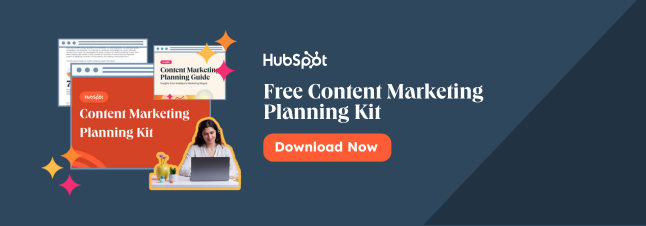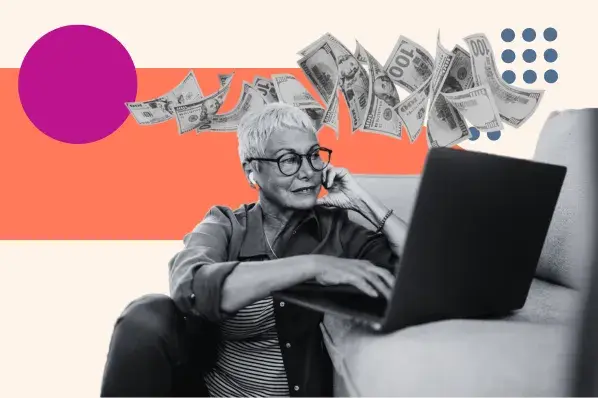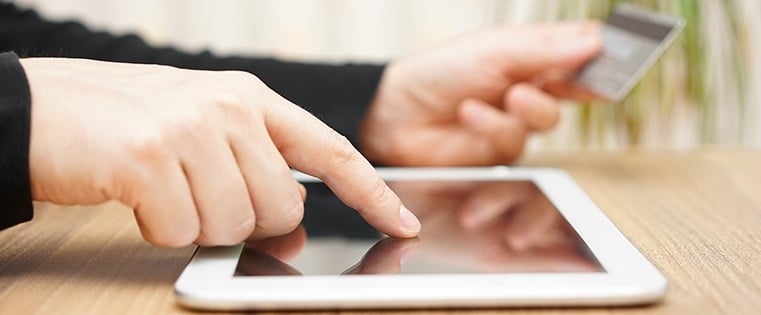Lead nurturing is a crucial part of your marketing and sales success. Studies show that 50% of leads are qualified but aren't immediately ready to buy something from you [Source: Gleanster Research]. With lead nurturing, however, you can bring those leads through your sales funnel and garner 4-10 times the response rate compared to a regular email blast while doing it [Source: SilverPop/DemandGen Report]. To nurture those leads correctly, however, you need to somehow adjust your messaging based on their point in the sales cycle. But how do you do that?
The best lead nurturing campaigns begin with content mapping, a process in which you decide what content is most appropriate for a person to receive at a given time. And to be honest, sometimes it feels like you have to be psychic to nail it. But while a little bit of psychic ability would certainly help, there's actually a structure you can follow to map your content very accurately for your lead nurturing campaigns -- after which you can simply make tweaks on your messaging, email sending frequency, and calls-to-action based on feedback, open rates, click-through rates, and other email marketing metrics. Here's how you can map lead nurturing content to every stage in the buying cycle.
Understanding the Buying Cycle
To understand content mapping for lead nurturing, you need to understand the buying cycle. People have broken it down into many sub-stages to align with their particular business model, but it can universally be boiled down to these three stages:
- Awareness: Leads have either become aware of your product or service, or they have become aware that they have a need that must be fulfilled.
- Evaluation: Leads are aware that your product or service could fulfill their need, and they are trying to determine whether you are the best fit.
- Purchase: Leads are ready to make a purchase.
Content mapping becomes important during these stages because prospects' needs are different depending on which stage in the buying cycle they fall into. David Skok explained the buying cycle well on For Entrepreneurs with a retail scenario. When you're walking around on the weekend and wander into a store with nothing in particular you're looking to buy, you don't want too much attention from a hungry sales person. It's annoying, because you're in the awareness stage. But when you make a beeline for the store because you need to buy a black sweater immediately, you want a sales person to approach you right away so you can find the sweater, purchase it, and get out of there. That's because you're in the purchase stage of the sales cycle.
The same concept applies when someone is interacting with your brand online. If they're just seeing you for the first time, they have different informational needs -- and thus require different content -- than someone who is ready to purchase something from you. Mapping the most appropriate content to each stage in the buying cycle will help you speak to the individual needs of each lead so you're having the right conversation with the right people at the right time.
How Content Mapping Works
Doing content mapping is very specific to each individual business -- you have a different sales cycle, different buyer personas, and different content assets and topics than other businesses -- but the content mapping structure outlined in this section will be transferable to any scenario. Here are the 4 questions you need to ask yourself when content mapping.
1.) What are the logical pathways to take a lead from awareness, to evaluation, to purchase?
Content mapping can be tricky because you have to work backwards. Start by determining the logical pathway a lead would take when navigating through the sales funnel. To do this, you'll need to lay out several scenarios in which leads convert into customers, and trace back which actions they took from their first conversion to close. If you're using HubSpot software, you can take a look at the activity history of leads to see what patterns emerge.

What pages did they visit? In what order? What offers did they convert on? What emails did they click through? Here's an example of what a logical conversion pathway might look like:
Visit company blog >> Convert on ebook call-to-action >> Click through to site on ebook nurturing campaign offer >> Navigate to Product/Service pages >> Click through to site on case study nurture email and download data sheet >> Receive free trial email >> Download free trial >> Receive coupon >> Become a customer
There will be more than one logical conversion pathway, but as you examine how your leads have historically converted into customers, a few pathways will emerge as the most common, the shortest, and the most profitable.
As you're determining these conversion pathways, you may notice that there are pieces of content, calls-to-action, or nurturing campaign emails that you aren't sending out yet, but should be. That's okay! One of the benefits of doing content mapping -- aside from improved content relevancy for your lead nurturing campaigns -- is identifying holes in your content strategy that you can now remedy.
2.) What specific content assets can be deployed along those pathways to help advance leads to the next stage in the buying cycle?
Now that you know the logical pathways a lead might take to convert into a customer, what type of content assets should they receive to nurture them along that path? It seems like the options are endless, but there are actually certain types of content that are more appropriate for certain stages in the sales cycle than others. Reference this table of content asset types that are aligned with their appropriate stage in the sales funnel.

The content assets listed in the 'Awareness' stage are appropriate for that stage of the buying cycle because they help educate your lead -- not on your solution, but on their need. The content assets in the 'Evaluation' stage, however, speak directly to how your company can help solve their needs, bridging the gap between the educational assets and product/service information. The assets in the 'Purchase' stage require more action from the lead -- actions the lead is more likely to take because they're now more educated about their problem and why your company is a good choice for solving it.
You'll notice some content asset types appear in more than one stage of the buying cycle -- webinars, for example. This is due to the content in that content asset type. A webinar from the 'Awareness' stage of the buying cycle would be educational about a general subject matter, while a webinar from the 'Evaluation' stage would be centered around your specific solution.
When assigning content asset types to the touchpoints in your conversion pathway, you should also assign topics to those assets. Those topics will obviously change depending on the nature of your business, but here's an example of how to execute this step correctly based on the conversion pathway defined above:
Visit Unicorn blog >> Convert on Unicorn Hygiene ebook >> Click through to site on ebook nurturing campaign offer "10 Best Tools for Grooming a Unicorn" >> Navigate to Unicorn Accessories product pages >> Click through to site on Glittery Farms Unicorn Grooming Case Study nurture email and download Unicorn Grooming FAQ >> Receive Unicorn Grooming Kit Coupon email >> Redeem coupon and become a customer
Notice how the content asset types move along from 'Awareness' assets -- like an ebook -- to 'Evaluation' assets -- like a case study -- to 'Purchase' assets -- like a coupon. We will examine an example of a real business' content asset types and how they map to a conversion path later in this post as well.
3.) What content assets are you missing?
At this point you might be saying, "That's great, but I don't have all of those content assets at the ready." That's ok. Remember, in addition to knowing when and where to use your content assets, part of content mapping is identifying which content assets you need to create to execute lead nurturing effectively. Once you've created your list of content assets and where they belong on the conversion pathway, perform a content audit to see what assets you already have and which ones you need to create. Then get going with content creation!
4.) How do you need to adjust the messaging in those content assets to align with the persona to whom you're speaking?
If you haven't created buyer personas yet, pause at this step in your content mapping exercise, read this guide to creating buyer personas, and create them. Pay particular attention to the question of how to identify the personas -- if you can't identify them based on their information and behaviors, you can't appropriately target your marketing to them.
For example, a company that sells personal tax software may find that they have two buyer personas -- one that is identified as a professional accountant, the other identified as an individual looking to prepare his or her own taxes. You wouldn't speak to these two audiences the same way, right? That's why it's important to not only create your buyer personas, but ask them to self identify when they become a lead so you can appropriately segment them in your lead nurturing, create content messaged just for them, and map the content appropriately.
If you have created your buyer personas, ask yourself how you need to tweak the messaging in your already existing content assets (and those on your list to create) to speak most appropriately to each persona. Some content assets you may find can exist as they are -- an FAQ about your product or service, for example -- while others may need to be rewritten -- like a case study, perhaps -- to be more easily digestible for two personas who don't quite speak the same language.
Applying Content Mapping to a Real-Life Scenario
Now you know how to map content to each stage in the buying cycle, but let's take it from (unicorn) theory to real life application. HubSpot customer Magic Software successfully moves leads who filled out a form to receive an educational whitepaper -- a top of the funnel offer -- through the 'Awareness' stage of the buying cycle to the 'Purchase' stage with these content asset types. Take a look:
Step 1: Download an educational whitepaper -- this lead is in the 'Awareness' stage and is looking to learn about integrating two pieces of software.

Step 2: Instead of pushing the lead right to the 'Evaluation' stage, this email encourages the lead to review more educational content in their Resource Center about software integration.

Step 3: Now that the lead has spent some time reading educational materials, it's time to move them gently along to the 'Evaluation' stage of the buying cycle by offering some software integration webinars. The lead is still being educated, but webinars are a more time intensive content asset to consume, and indicate a lead's willingness to seriously consider your solution.

Step 4: Still in the 'Evaluation' stage, this email makes the jump from the webinar -- educational but high-commitment content -- to content centered around the solution they offer. Now the lead is ready to read about how a Magic Software product can solve their software integration problem through its product documentation.

Step 5: Finally, this lead moves to the 'Purchase' stage of the buying cycle with high-commitment content. This email asks the lead to sign up for product training -- an offer only a lead seriously considering a purchase would redeem. Because this lead wasn't rushed through the buying cycle, but instead received content appropriate for their level of interest and education, they are in a far better position to turn into a customer.

Have you mapped content to each stage in your sales funnel? Share tips from your experience in the comments!
Image credit: Sudhamshu








![How to Expand Your Lead Nurturing Strategy Beyond Just Email [SlideShare]](http://cdn2.hubspot.net/hub/53/file-1390659247-jpg/Blog_Thinkstock_Images/lead_nurturing.jpg)



